- Congenital Deformity & Clubfoot

Congenital deformities of the lower limbs are developmental disorders that are present at birth, causing alterations in the shape and appearance of the legs. Several factors such as genetics, teratogenic drugs, and chemicals can cause congenital deformities.
Know More - Charcot Foot Deformity
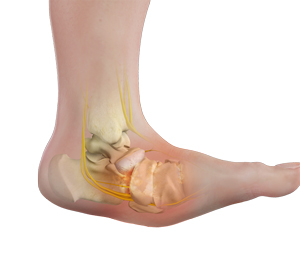
Charcot foot deformity, also known as Charcot arthropathy, is a condition characterized by weakness and inflammation of the bones, joints, and tissues of the foot. If not treated appropriately, it can lead to joint collapse and loss of mobility.
Know More - Cavus Foot Deformity
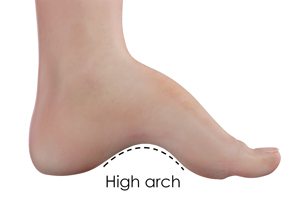
Cavus foot also referred to as a high arch, is a condition in which the arch on the bottom of the foot that runs from the toes to the heel is arched more than normal. Because of this, excessive weight falls on the ball and heel of the foot when walking or standing, causing pain and instability.
Know More - Achilles Tendon Rupture

The Achilles tendon is a strong fibrous cord present behind the ankle that connects the calf muscles to the heel bone. It is used when you walk, run and jump. The Achilles tendon ruptures most often in athletes participating in sports that involve running, pivoting and jumping. Recreational sports that may cause Achilles rupture include tennis, football, basketball, and gymnastics.
Know More - Ankle Sprain
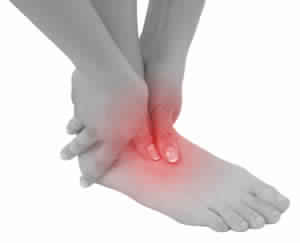
A sprain is the stretching or tearing of ligaments. Ligaments connect adjacent bones and provide stability to a joint. An ankle sprain is a common injury that occurs when you suddenly fall or twist the ankle joint, or when you land your foot in an awkward position after a jump.
Know More Launch Movie - Ankle Instability

Ankle instability is a chronic condition characterized by a recurrent slipping of the outer side of the ankle. It usually results from repeated ankle sprains, which are injuries to the ligaments. Ankle instability is generally noticed when you move your ankle joint but can also occur while standing.
Know More - Turf Toe
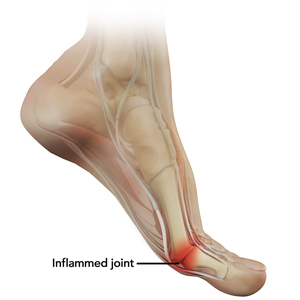
Turf toe is an injury to the ligament at the base of the big toe. It is a painful condition that usually results from jamming the toe into the ground or excessive backward bending of the toe.
Know More - Shin Splints
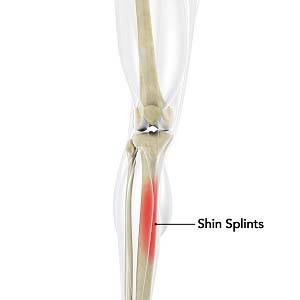
Shin splints or medial tibial stress syndrome (MTSS) is pain around the tibia or shinbone due to inflammation of the tendons, muscles and bone tissue. It occurs because of vigorous exercises and sports activities.
Know More - Foot & Ankle Trauma
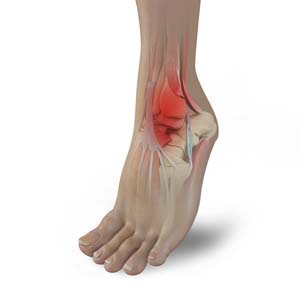
Foot and ankle trauma refers to injuries that most commonly occur during sports, exercise or any other physical activity. Trauma may be a result of accidents, poor training practices or use of improper gear.
Know More - Ankle Fractures
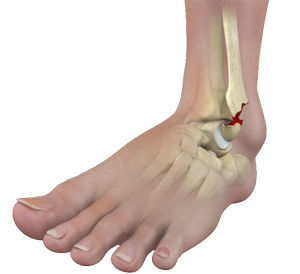
An ankle fracture is a painful condition where there is a break in one or more bones forming the ankle joint. The ankle joint is stabilized by different ligaments and other soft tissues, which may also be injured during an ankle fracture.
Know More Launch Movie - Foot Fracture
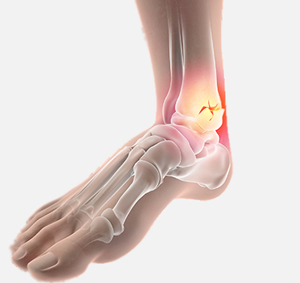
Foot fractures commonly occur because of a fall, motor vehicle accident, dropping a heavy object on your foot or from overuse such as with sports.
Know More Launch Movie - Talus Fractures
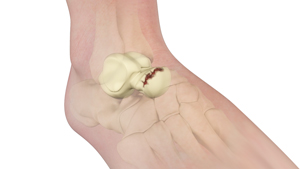
The talus is a small bone at the ankle joint that connects the heel bone and the shinbones, enabling up and down movement of the foot.
Know More - Calcaneal Fracture
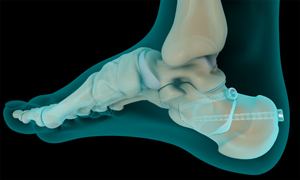
Coming soon
Know More - Lisfranc (Midfoot) Injury

A Lisfranc injury can occur due to the twisting of the foot (low-energy injury), a fall from a height or a traumatic motor accident (high-energy injury).
Know More - Foot & Ankle Arthritis

Arthritis is the inflammation of joints as a result of degeneration of the smooth cartilage that lines the ends of bones in a joint. This degeneration of the cartilages leads to painful rubbing of the bones, swelling, and stiffness in the joints, resulting in restricted movements.
Know More - Ankle Rheumatoid Arthritis

Rheumatoid arthritis is an auto-immune disease in which the body’s immune system (the body’s way of fighting infection) attacks its own healthy joints, tissues, and organs. It can cause pain, stiffness, swelling, and loss of function in the joints.
Know More - Foot Rheumatoid Arthritis

Rheumatoid arthritis affects mostly the joints of the hands and feet and tends to be symmetrical. This means the disease affects the same joints on both sides of the body (ex. both feet) at the same time and with the same symptoms.
Know More - Midfoot Arthritis

Midfoot arthritis is pain and inflammation of the midfoot. It occurs due to damage of cartilage or tissues around the joints. The damage may occur due to injury, aging or autoimmunity.
Know More - Plantar Fasciitis

Plantar fasciitis refers to the inflammation of the plantar fascia, a thick band of tissue that is present at the bottom of the foot. It runs from the heel bone to the toes and forms the arch of your foot.
Know More Launch Movie - Foot Pain

Foot pain occurs from distress induced by certain factors on the foot. It is a common problem experienced by young athletes involved in various activities such as running and jumping.
Know More - Heel Pain

The heel is made up of the calcaneus bone and supported by a network of muscles, tendons, ligaments and soft tissues, which together support the weight of the body and stress during movement.
Know More - Bunion

A bunion is a bony protuberance that appears on the outer surface of the big toe when it angles toward the adjacent toe. It is an extra bone and a fluid-filled sac that grows at the base of the big toe.
Know More Launch Movie - Bunionette

Bunionette also referred to as a tailor’s bunion is a bony lump that grows on the outside of the foot at the base of your little toe. The deformity got its name as q tailor’s bunion when tailors once sat with their legs crossed all day, with the outside edge of their feet rubbing on the ground.
Know More - Hallux Rigiditis

Hallux Rigiditis is a form of degenerative arthritis at the metatarsophalangeal or MTP joint where the base of your big toe attaches to the foot. Arthritis is the inflammation of joints as a result of degeneration of the smooth cartilage that lines the ends of bones in a joint.
Know More - Heel Spurs

Heel spurs occur when calcium deposits build up on the underside of the heel bone, a condition that develops over time. Heel spurs are caused by stretching of the plantar fascia or foot ligaments and muscle strains.
Know More - Ganglion & Soft Tissue Tumors

A ganglion is a round, sac-like swelling or a fluid-filled lump under the skin near your foot and ankle joint. It can become bigger or smaller over time and may be visible or not, especially if it is small.
Know More - Foot Problems

Foot problems can involve any part of the foot. They may involve the skin, tendons, ligament, heels, toes, blood vessels, and joints of the foot.
Know More - Heel Fractures

A fracture of the heel bone occurs most commonly due to a traumatic event such as falling from a height, twisting injuries, motor vehicle accidents and ankle sprains.
Know More - Forefoot Pain

The forefoot is the anterior portion of the foot formed by five metatarsals, fourteen phalange bones, and various soft tissues. This complicated structure makes pain in this region more complex to diagnose.
Know More - Achilles Tendon Bursitis

Achilles tendon bursitis or retrocalcaneal bursitis is a condition that commonly occurs in athletes. It is a painful condition caused by the swelling of the bursa, a fluid-filled sac that is located at the back of the heel under the Achilles tendon.
Know More - Morton's Neuroma

Morton’s neuroma refers to a nerve injury that occurs between the toes, usually the third and fourth toes. This causes pain and thickening of the nerve tissue.
Know More - Ankle Ligament Injury

An ankle ligament injury, also known as an ankle sprain, can be caused by a sudden twisting movement of the foot during any athletic event or during daily activities.
Know More - Flatfoot

Flatfoot, also known as “fallen arches” or Pes planus, is a deformity in children’s feet where the arch that runs along the sole of the foot collapses to the ground or is not formed at all.
Know More - Ankle Dislocation

Ankle dislocation is a condition that occurs when the bones of the lower leg called the fibula and tibia get separated from the talus or ankle bone. This can cause serious damage to the nerves and ligaments surrounding the ankle, leading to a decline in strength and overall health of the leg.
Know More - Burning Neuropathic Pain

Burning neuropathic pain is a chronic condition characterized by a painful stinging and burning sensation as a result of injury or damage to a nerve or due to malfunctioning of the nervous system.
Know More - Freiberg's Disease

Freiberg’s disease, also known as Freiberg infraction, is a condition characterized by avascular necrosis (death of bone tissue due to lack of blood supply) mostly in the second or third metatarsal bones located at the base of the second and third toes of the feet.
Know More - Lesser Toe Deformities

Lesser toe deformity is an abnormality in the anatomy of your toe that occurs as a result of imbalance between the intrinsic and extrinsic muscles.
Know More - Haglunds Deformity

Haglund’s deformity, also known as “pump bump”, is a condition in which bony extensions are formed at the back of the heel, leading to swelling near the Achilles tendon.
Know More - Peroneal Tendon Dislocation

Peroneal tendon dislocation is common in athletes with unstable ankles due to overuse or repeated ankle sprains. It can occur when the foot is inverted and forcefully raised during an injury.
Know More - Foot Cancer

Foot cancer is a condition characterized by the formation of lesions, cysts, or outgrowths in the feet due to the uncontrolled multiplication of cells. There are many types of foot cancer; some are localized while others are widespread.
Know More - Osteochondral Injuries of the Ankle

Osteochondral injuries are most often caused by trauma to the ankle joint, such as with ankle sprains. Some cases may not have any previous history of ankle injury and may be caused by local osteonecrosis or a metabolic defect.
Know More - Hallux Limitus

Hallux limitus is a condition characterized by stiffness and decreased movement of the big toe. As the condition progresses, bone spurs and arthritis may develop in the toe joint (metatarsophalangeal joint), eventually leading to complete joint rigidity.
Know More - Lisfranc (Midfoot) Fracture
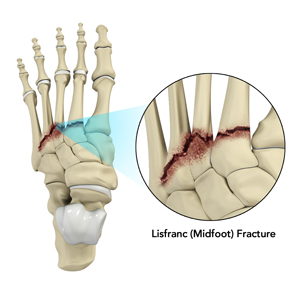
The Lisfranc joint or tarsometatarsal joint refers to the region in the middle of the foot. It is a junction between the tarsal bones (bones in the foot arch) and metatarsal bones (five long bones in the foot). Lisfranc fractures can occur due to a fall from a height or a traumatic motor vehicle accident.
Know More - Intoeing

Intoeing, also called “pigeon-toed”, is an abnormal condition characterized by the inward facing of the toe or foot instead of being straight. You may observe intoeing in your child at an early age when they start walking.
Know More - Plantar Fibromas

A plantar fibroma is a benign fibrous lump that may develop in the plantar fascia, the tissue under the foot that extends across the arch. It can develop in one or both feet.
Know More - Sesamoiditis

Sesamoids are two small, pea-shaped bones located in the ball beneath the big toe joint at the bottom of the foot. Sesamoid bones are connected to muscles and other bones by tendons that envelop these bones.
Know More - Foot Drop

Foot drop, also known as drop foot, is a sign of an underlying muscular, neurological or anatomical condition, where you are unable to lift the front part of your foot, which results in the dragging of the foot.
Know More - Hammertoe

A hammertoe is a deformity of a lesser toe (second through fifth toes), where the toe is bent upward at the toe’s middle joint, resembling a hammer. The bent portion may rub against the shoe causing pain, irritation and develop corns.
Know More - Nerve Conditions of the Foot

Nerve conditions of the foot can range from minor nerve injuries to serious conditions like nerve entrapment and damage. A podiatrist is a doctor specializing in the treatment of foot problems including nerve conditions.
Know More - Foot Spasms

Foot spasms, also known as foot cramps, occur due to the involuntary contraction of the foot muscles. These cramps are usually harmless and will get better on their own; however, sometimes they may need medical attention.
Know More - Kohler Disease

Kohler disease is a rare bone disorder in children characterized by pain and swelling along the arch of one or both feet. It is commonly seen between the ages of 5 and 7, with boys 4-5 times more likely to be affected. It is usually a self-limiting condition.
Know More - Claw Toe

Claw toe is a deformity where a toe bends and appears like a bird’s claw. The affected toe is bent upward from the joint at the ball of the foot, and downward at the joints in the middle and tip of the toe to curl under the foot.
Know More - Congenital Limb Deformities

Congenital deformities of the lower limbs are developmental disorders that cause alterations in the shape and appearance of the legs. Several factors, including genetics, influence the fetal growth in the womb, and exposure to teratogenic drugs and chemicals can increase the risk of congenital deformities.
Know More - Ingrown toenail

Ingrown toenails occur most often by wearing tight shoes, having unusually curved nails that grow downward or trimming your nails too short.
Know More - Foot Lesions

A foot lesion is an abnormal change in an area of skin on the foot. It may be caused by infection, injury or abnormal growth of tissue. Foot lesions are commonly seen in diabetic patients due to nerve damage and poor circulation.
Know More - Sever's Disease

Sever’s disease is a painful inflammation of the growth plate in the heel. Growth plates are areas at the end of children’s bones that undergo changes so bone growth can occur. During this time, the muscles and tendons may not grow as fast as the bone causing tightness and pressure at the back of the heel.
Know More Launch Movie - Fifth Metatarsal Fractures

The fifth metatarsal is the long bone that is located on the outside of the foot and connects to the small toe. The fifth metatarsal bone is more commonly fractured.
Know More - Mallet Toe

Mallet toe is a deformity where the toe abnormally bends downward, resembling a hammer or mallet. The bones at the tip of the toe are connected by the distal interphalangeal joint (DIP).
Know More - Metatarsal & Phalangeal (Forefoot) Fractures

The forefoot is the anterior or front portion of the foot that functions in weight-bearing and maintaining balance while standing, walking or running. It is formed by 5 metatarsal bones, 14 phalange bones, and various soft tissues. A forefoot fracture is a crack or breaks in any of these bones.
Know More - Sesamoid Fracture

A sesamoid fracture is a break in the sesamoid bone. Sesamoids are two small, pea-shaped bones located in the ball beneath the big toe joint at the bottom of the foot. Sesamoid bones are connected to muscles and other bones by tendons that envelop these bones. Sesamoids help the big toe move normally and absorb the weight placed on the ball.
Know More - Diabetic Foot Conditions

Diabetes is a chronic condition that is characterized by high blood glucose (sugar) levels. Diabetic patients are at high risk for developing chronic wounds, especially in the feet. If left untreated, these wounds can cause serious problems that can lead to infections and eventually gangrene, which may require amputation.
Know More - Posterior Tibial Tendon Dysfunction

The posterior tibial tendon passes through the ankle to attach the calf muscle with the bones of the midfoot. It provides stability to the arch and supports the foot while walking. Inflammation or a tear of this tendon as a result of injury may cause dysfunction, leading to pain and the development of a flatfoot.
Know More - Foot Inflammation

Foot inflammation is the result of a person’s immune response towards various irritants or injuries to the foot. Based on the type of response, the inflammation can be classified as acute when it occurs suddenly, or chronic, occurring gradually as a result of a long-term disorder.
Know More - Stress Fractures of Foot & Ankle

A stress fracture is described as a small crack in the bone which occurs from an overuse injury of a bone. It commonly develops in the weight-bearing bones of the lower leg and foot. When the muscles of the foot are overworked or stressed, they are unable to absorb the stress and when this happens the muscles transfer the stress to the bone which results in stress fracture.
Know More - Bunionette (Tailor's Bunion)

Bunionette, also called Tailor’s bunion, is a bony lump formed along the outside of the little toe at the base. It occurs when the very bottom bone (fifth metatarsal bone) of the little toe enlarges or shifts outward. Sometimes, it can be a bony spur (an outgrowth of bone) on the side of the fifth metatarsal bone head.
Know More - Achilles Tendinitis

The Achilles tendon is a tough band of fibrous tissue that runs down the back of your lower leg and connects your calf muscle to your heel bone. The tendon is used when you walk, climb, jump, run and stand on your tip toes.
Know More - Metatarsalgia

Metatarsalgia is a condition in which pain and inflammation are caused due to overuse or injury to the ball of the foot - the area between the toes and the arch. This condition mainly affects the joints at the base of the five-toe bones.
Know More - Osteochondral Lesions of the Ankle

Osteochondral lesions are diagnosed by a physical examination, X-ray, and CT and MRI scans. Plain X-ray images can reveal other fractures, bone spurs, and narrowing of the joint. A CT scan helps identify any bony fragments but is not very helpful to visualize bone edema or cartilage defects.
Know More - Adult Leg Length Discrepancy

Adult leg length discrepancy is a condition in which an individual’s legs are of unequal length with one leg shorter than the other. This can occur as a result of fractures or bone diseases.
Know More - Pediatric Foot Conditions

Pediatric foot conditions refer to a wide range of foot disorders that may affect the muscles, tendons, and bones of the foot causing significant foot deformity and functional limitations.
Know More - Overlapping or Underlapping Toe

An overlapping or underlapping toe is an abnormal condition in which a toe overlaps or underlaps the toe next to it. Although this can happen with any toe, it usually affects the fifth and second toes. The toe may be flexible, allowing it to return to its normal position, or it may be rigid and fixed.
Know More - Stiff Big Toe (Hallux Rigidus)

A stiff big toe, also called hallux rigidus, is a form of degenerative arthritis affecting the joint where the big toe (hallux) attaches to the foot. The toe typically becomes stiff at the base and is sometimes called a “frozen joint”.
Know More - Tarsal Tunnel Syndrome

The tarsal tunnel is a narrow passageway that lies on the inside of your ankle and runs into the foot. It encloses arteries, veins, tendons and nerves that supply the foot.
Know More - Vertical Talus

A vertical talus, also called “congenital vertical talus or CVT”, is a rare foot deformity typically seen at the time of birth. The condition may affect one foot or both feet of your baby.
Know More

